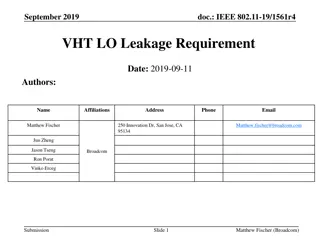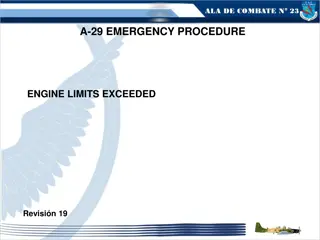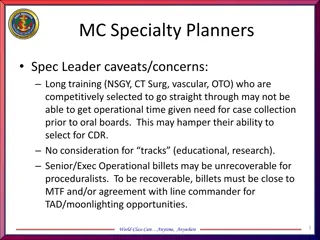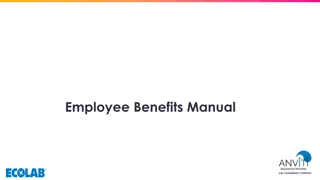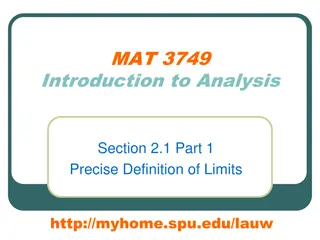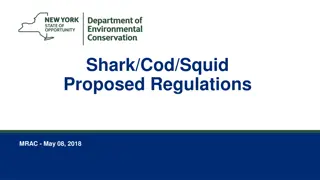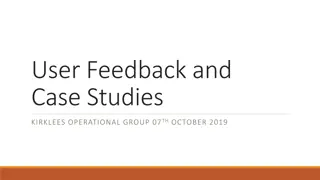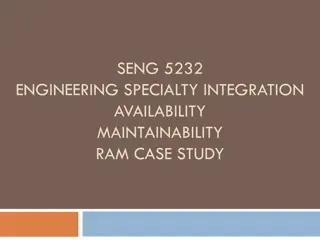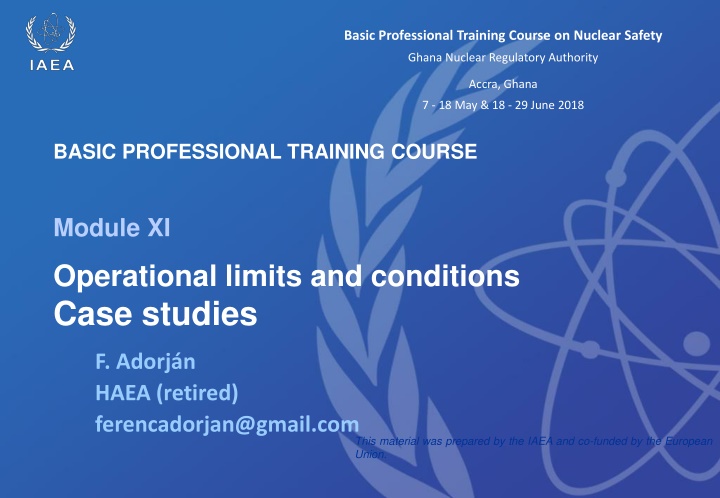
Operational Limits and Safety Systems in Nuclear Industry
Explore a professional training course focusing on operational limits, safety systems, and case studies in nuclear safety. Learn about safety limits, system settings, and operational limits through critical case studies. Discover the importance of monitoring parameters and prompt actions in maintaining nuclear safety standards.
Download Presentation

Please find below an Image/Link to download the presentation.
The content on the website is provided AS IS for your information and personal use only. It may not be sold, licensed, or shared on other websites without obtaining consent from the author. If you encounter any issues during the download, it is possible that the publisher has removed the file from their server.
You are allowed to download the files provided on this website for personal or commercial use, subject to the condition that they are used lawfully. All files are the property of their respective owners.
The content on the website is provided AS IS for your information and personal use only. It may not be sold, licensed, or shared on other websites without obtaining consent from the author.
E N D
Presentation Transcript
Basic Professional Training Course on Nuclear Safety Ghana Nuclear Regulatory Authority Accra, Ghana 7 - 18 May & 18 - 29 June 2018 BASIC PROFESSIONAL TRAINING COURSE Module XI Operational limits and conditions Case studies F. Adorj n HAEA (retired) ferencadorjan@gmail.com This material was prepared by the IAEA and co-funded by the European Union.
CASE STUDY Case study: The interrelationship between a safety limit, a safety system setting and an operational limit. The critical parameter of concern is the fuel cladding temperature. Correlation has been established between a monitored parameter, coolant temperature and the maximum fuel cladding temperature, for which a safety limit has been established. The safety analysis shows that actuation of the safety system by the monitored coolant temperature at the safety system setting prevents the fuel cladding temperature from reaching the set safety limit beyond which releases of significant amounts of radioactive material from the fuel might occur. Module XI. Case study 7 - 18 May & 18 - 29 June 2018 2
CASE STUDY Module XI. Case study 7 - 18 May & 18 - 29 June 2018 3
CASE STUDY Range of steady state operation: The monitored parameter is kept within the steady state range by the control system or by the operator in accordance with the operating procedures. Alarm setting exceeded (curve no. 1): The temperature rise reaches an alarm setting, Operator will be alerted and will take action to: Reduce power or start some additional system in order to reducing temperature to the normal operational range, to prevent the temperature to reach the operational limit for normal operation. The delay in the operator s response is taken into consideration. Module XI. Case study 7 - 18 May & 18 - 29 June 2018 4
CASE STUDY Operational limit exceeded (curve no. 2): Limits for normal operation is set at any level between the range of steady state operation and the actuation setting for the safety system. Normally there is margin between alarm setting and operational limit. There is also a margin between the operational limit and the safety system setting: to allow the operator to take action to control a transient without activating the safety system. If the operational limit is reached and the operator takes corrective action to prevent the safety system setting being reached, then the transient will be of the form of curve 2. Module XI. Case study 7 - 18 May & 18 - 29 June 2018 5
CASE STUDY Safety system setting exceeded (curve no. 3): If control system or operator fail to control the monitored parameter it reaches the safety system setting at point A: the safety system is actuated. Corrective action becomes effective at point B owing to inherent delays in the instrumentation and equipment of the safety system. The response is sufficient to prevent the safety limit being reached, although some limited cladding damage cannot be excluded. Module XI. Case study 7 - 18 May & 18 - 29 June 2018 6
CASE STUDY Safety limit exceeded (curve no. 4) : In the event of a failure that exceeds the most severe one, or a failure or multiple failures in a safety system, the temperature of the cladding may exceed the value of the safety limit, significant amounts of radioactive material are released. Additional safety systems are actuated by other parameters: to bring other engineered safety features into operation, to mitigate the consequences, measures for accident management are activated. The views expressed in this document do not necessarily reflect the views of the European Commission. Module XI. Case study 7 - 18 May & 18 - 29 June 2018 7
Exercise Where should the following sentences be placed: A. In the Safety Limits section of OLC B. In the LCs of normal operation section of OLC C. In an operating procedure for the reactor operator 1. When the Alarm Primary coolant temperature exceeds 325 Centigrade is set, the reactor power shall be reduced by 10% and system Y shall be turned on, immediately! 2. The primary coolant temperature shall be maintained all the time below 333 Centigrade! If exceeded, the total power shall be reduced until the average coolant temperature is below 323 Celsius. 3. The set-point for starting the high pressure safety injection system is 345 Centigrade. Module XI. Case study 7 - 18 May & 18 - 29 June 2018 8
Basic Professional Training Course on Nuclear Safety Ghana Nuclear Regulatory Authority Accra, Ghana 7 - 18 May & 18 - 29 June 2018 Use this box for any additional message Thank you!






